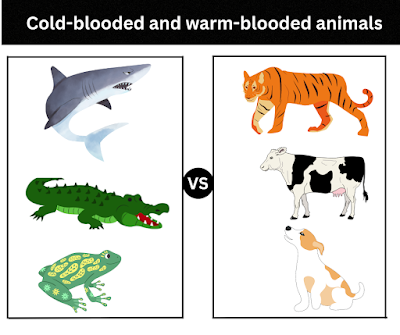Cold blooded vs Warm blooded animals: Definition, Differences & Examples
On the basis of regulating internal body temperature, there are two types of animals, that are Cold blooded animals and warm blooded animals. In simple language, animals that cannot regulate their internal body temperature according to the external environment's temperature are known as cold blooded animals. While Animals that can maintain their internal body temperature irrespective of the environment's temperature are known as warm blooded animals.
 |
| Cold blooded and Warm blooded animals |
Cold blooded animals definition
- The body temperature of cold blooded animals is keep changing as they move to different habitats due to changes in external temperature.
- They cannot survive in extreme temperatures as their body temperature is not constant and keeps changing.
- They can survive on very less amount of food as they do not need much energy to survive.
- They are much more resistant to the disease and use their body temperature as a defense mechanism against diseases.
- They lower their body temperature if they got any diseases which helps them to recover.
- They have two phases i.e. Hibernation and Aestivation.
- In winter, they rest in warm places. The winter resting period is known as Hibernation.
- In summer, they rest in cool and shady places. The summer resting period is called Aestivation.
- Examples of cold blooded animals are fish, reptiles, frogs, crocodiles, amphibians, bees, moths, and termites.
- There are three types of cold blooded animals: ectothermy, poikilothermy, and bradymetabolism.
- Ectothermy- Cold blooded animals of this group maintain their body temperature according to the external environment's temperature. Example- Reptiles.
- Poikilothermy- The body temperature of cold blooded animals of this group fluctuates with the change in temperature of the surrounding. Example- Frogs and turtles.
- Bradymetabolism- Cold blooded animals of this group maintain their temperature according to the rate of metabolism. Example- Insects.
Warm blooded animals definition
- The body temperature of these animals remains constant throughout their life i.e. in the range of 35 to 40 degree Celsius.
- Mitochondria of warm blooded animals produce heat energy which is utilized to maintain the internal body temperature.
- These animals are also known as homeothermic animals and use thermal homeostasis to maintain their body temperature.
- They have a strong immune system to fight against diseases and a high metabolism rate.
- These animals are active in both winter and summer or warm and cold.
- Examples of warm blooded animals are Birds and Mammals.
- There are three types of warm blooded animals: endothermy, homeothermy, and tachymetabolism.
- Endothermy- Warm blooded animals of this group maintain their body temperature by the use of internal means like sweating, shivering, etc. For example a dog.
- Homeothermy- The animal's body of this group regulates its internal temperature irrespective of the external temperature. For example humans.
- Tachymetabolism: These warm blooded animals use a high metabolism rate to maintain their body temperature. For example birds.
Major Differences (Cold blooded vs warm blooded animals )
|
Basic for comparison |
Cold blooded animals |
Warm blooded animals |
|
Definition |
Animals that cannot regulate their internal body temperature
according to the external environment's temperature are known
as cold blooded animals. |
Animals that
can maintain their internal body temperature irrespective of the
environment's temperature are known as warm blooded animals. |
|
Also Known
as |
Poikilothermic
animals |
Homeothermic
animals |
|
Types |
Cold blooded animals are divided into three groups: EctothermyPoikilothermy Bradymetabolism |
Warm blooded
animals are divided into three groups: Homeothermy Tachymetabolism |
|
Temperature
dependency |
Cold blooded animals are dependent on the external environment’s temperature. |
Warm blooded
animals are not dependent on the external environment’s temperature. |
|
Metabolic
rates |
Cold blooded animals' metabolic rate changes according to the environment. |
Warm blooded
animals have no effect on metabolic
rate according to the environment. |
|
Phase |
They
undergo two phases that are hibernation and aestivation. |
Most of
them do not undergo any phases. |
|
Organ
system |
They do not
have a high-energy organ system. |
They have
complex organ systems. |
|
Heat
regulation |
They
regulate heat in their body by stretching out limbs in sunlight, changing body
colors, bathing under the sun, etc |
They
regulate their body temperature by different metabolic activities and
adaptive activities like sweating, shivering, etc. |
|
Resistance
against diseases |
They use
their body temperature as a mechanism to fight against disease. They also
lower their body temperature to recover. |
Warm blooded
animals have a robust immune system to fight against diseases. |
|
Energy
production |
They gain
energy in the form of heat to regulate their body temperature |
They produce
heat within their own body. |
|
Survival
|
They cannot
survive extreme temperature |
They can quickly
adapt themselves to environmental and
temperature changes |
|
Heat
sources |
Cold blooded
animals get heat from direct sunlight. |
They can
produce heat themselves by consuming food. |
|
Proteins |
They have
different proteins, which perform at different temperature |
Proteins in
them are not temperature specific. |
|
Genome |
Their
genome can be more complex. |
Their
genome can be simpler. |
|
Effects
of body fat |
Excessive body fat can overheat their body temperature and can cause death. |
Body fat is
important in warm blooded animals to maintain body temperature. |
|
Examples |
Examples of
cold blooded animals are fishes, sharks, invertebrates, crocodiles, etc. |
Examples of
warm blooded animals are birds and mammals. |
